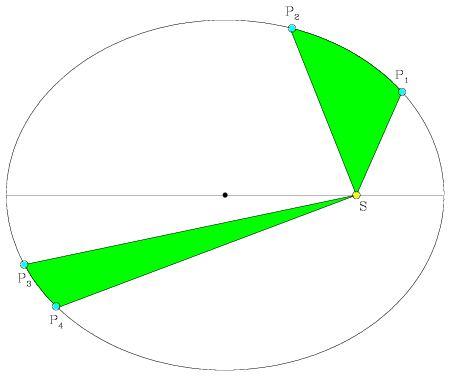
For any plane, the radius vector sweeps out equal areas in equal times.
 |
| [NMSU, N. Vogt] |
Consider the positions of a planet, P1, P2, P3, and P4, at times t1, t2, t3, and t4. Between times t1 and t2 the planet's radius vector sweeps out the area bounded by the radius vectors SP1, SP2 and the arc P1P2. Similarly, the area swept out by the radius vector in the time interval (t4-t3) is the area SP3P4. Then, Kepler's second law states that:
If t2-t1 =
t4-t3, then
area [SP1P2] =
area [SP3P4].
If the area is the area of the ellipse itself (which is given by  ab), the radius vector will be
back to its original position. Kepler's second law thus implies that the
planet's orbital period is constant.
ab), the radius vector will be
back to its original position. Kepler's second law thus implies that the
planet's orbital period is constant.
It is possible to derive a mathematical expression for Kepler's second law by supposing that the time interval (t2-t1) is very small and equal to interval (t4-t3). Position P2 will be very close to P1, just as P4 will be close to P3. The area SP1P2 is then approximately the area of triangle SP1P2, or
Using the small angle approximation,
 1.
1.
Also,
so that the area SP1P2 is given by
 1.
1.
Similarly, area SP3P4 is given by
 2,
2,where SP3 = r2 and angle
P3SP4 =
 2.
Let t4-t3 =
t2-t1 = t. Then, from
Kepler's second law,
2.
Let t4-t3 =
t2-t1 = t. Then, from
Kepler's second law,
 1 / t) =
½ r22(
1 / t) =
½ r22( 2 / t) =
constant.
2 / t) =
constant.
However,  /t is the
angular velocity,
/t is the
angular velocity,  ,
in the limit when t tends to zero. Hence
,
in the limit when t tends to zero. Hence
 1 =
½ r22
1 =
½ r22 2
= constant,
2
= constant,
is the mathematical expression of Kepler's second law. In order for this law to be obeyed, the planet has to move fastest when its radius vector is shortest, at perihelion, and slowest when it is at aphelion, as shown here.